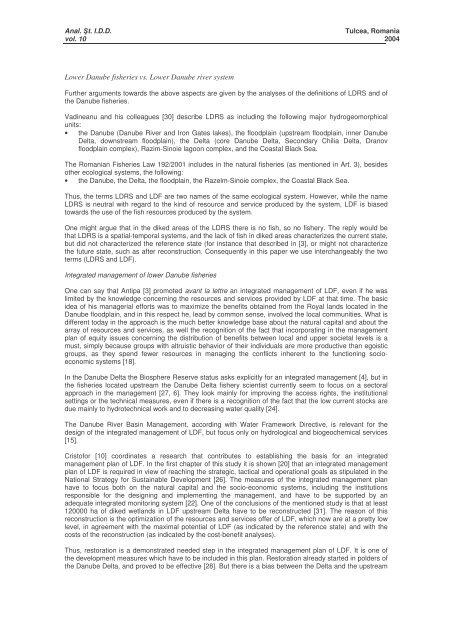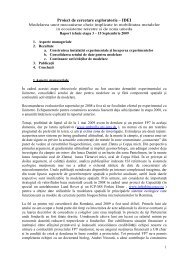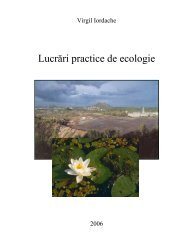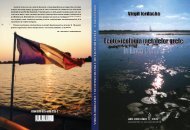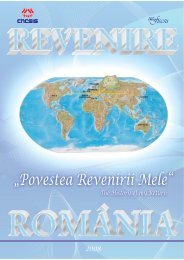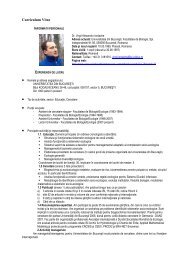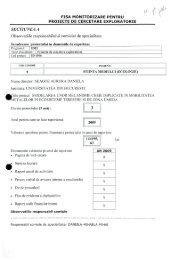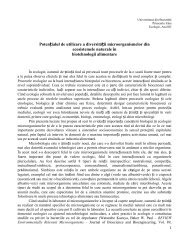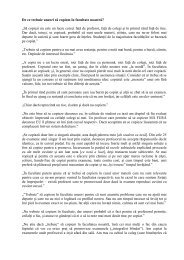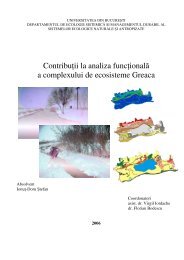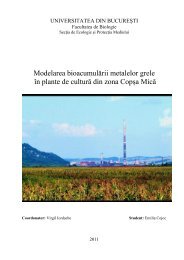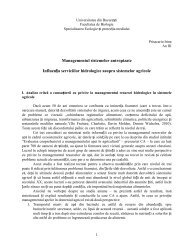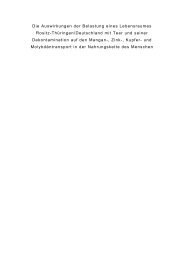Anal. t. I.D.D.Tulcea, Romaniavol. 10 2004Lower Danube fisheries vs. Lower Danube river systemFurther arguments towards the above aspects are given by the analyses of the definitions of LDRS and ofthe Danube fisheries.Vadineanu and his colleagues [30] describe LDRS as including the following major hydrogeomorphicalunits:• the Danube (Danube River and Iron Gates lakes), the floodplain (upstream floodplain, inner DanubeDelta, downstream floodplain), the Delta (core Danube Delta, Secondary Chilia Delta, Dranovfloodplain complex), Razim-Sinoie lagoon complex, and the Coastal Black Sea.The Romanian Fisheries Law 192/2001 includes in the natural fisheries (as mentioned in Art. 3), besidesother ecological systems, the following:• the Danube, the Delta, the floodplain, the Razelm-Sinoie complex, the Coastal Black Sea.Thus, the terms LDRS and LDF are two names of the same ecological system. However, while the nameLDRS is neutral with regard to the kind of resource and service produced by the system, LDF is biasedtowards the use of the fish resources produced by the system.One might argue that in the diked areas of the LDRS there is no fish, so no fishery. The reply would bethat LDRS is a spatial-temporal systems, and the lack of fish in diked areas characterizes the current state,but did not characterized the reference state (for instance that described in [3], or might not characterizethe future state, such as after reconstruction. Consequently in this paper we use interchangeably the twoterms (LDRS and LDF).Integrated management of lower Danube fisheriesOne can say that Antipa [3] promoted avant la lettre an integrated management of LDF, even if he waslimited by the knowledge concerning the resources and services provided by LDF at that time. The basicidea of his managerial efforts was to maximize the benefits obtained from the Royal lands located in theDanube floodplain, and in this respect he, lead by common sense, involved the local communities. What isdifferent today in the approach is the much better knowledge base about the natural capital and about thearray of resources and services, as well the recognition of the fact that incorporating in the managementplan of equity issues concerning the distribution of benefits between local and upper societal levels is amust, simply because groups with altruistic behavior of their individuals are more productive than egoisticgroups, as they spend fewer resources in managing the conflicts inherent to the functioning socioeconomicsystems [18].In the Danube Delta the Biosphere Reserve status asks explicitly for an integrated management [4], but inthe fisheries located upstream the Danube Delta fishery scientist currently seem to focus on a sectoralapproach in the management [27, 6]. They look mainly for improving the access rights, the institutionalsettings or the technical measures, even if there is a recognition of the fact that the low current stocks aredue mainly to hydrotechnical work and to decreasing water quality [24].The Danube River Basin Management, according with Water Framework Directive, is relevant for thedesign of the integrated management of LDF, but focus only on hydrological and biogeochemical services[15].Cristofor [10] coordinates a research that contributes to establishing the basis for an integratedmanagement plan of LDF. In the first chapter of this study it is shown [20] that an integrated managementplan of LDF is required in view of reaching the strategic, tactical and operational goals as stipulated in theNational Strategy for Sustainable Development [26]. The measures of the integrated management planhave to focus both on the natural capital and the socio-economic systems, including the institutionsresponsible for the designing and implementing the management, and have to be supported by anadequate integrated monitoring system [22]. One of the conclusions of the mentioned study is that at least120000 ha of diked wetlands in LDF upstream Delta have to be reconstructed [31]. The reason of thisreconstruction is the optimization of the resources and services offer of LDF, which now are at a pretty lowlevel, in agreement with the maximal potential of LDF (as indicated by the reference state) and with thecosts of the reconstruction (as indicated by the cost-benefit analyses).Thus, restoration is a demonstrated needed step in the integrated management plan of LDF. It is one ofthe development measures which have to be included in this plan. Restoration already started in polders ofthe Danube Delta, and proved to be effective [28]. But there is a bias between the Delta and the upstream
Anal. t. I.D.D.Tulcea, Romaniavol. 10 2004parts of LDF.The restoration of important floodplain areas is envisaged by the Program of ICPDR (ICPDR, 2001).According to this plan, Romania has to invest 73.9 millions Euro for restoring five local landscapes. Theobjectives of ICPDR for this restoration are related mainly to water quality improvement. The restorationsites are those established within the Lower Danube Green Corridor program promoted by WWF, and aregovernmentally supported also by the Declaration signed by Romania, Bulgaria, Ukraine, and Moldova inJune 2000. The sites do not include the major islands of the Inner Danube Delta (such as the Big Island ofBraila), former very important fisheries [3], dominated now by state agricultural farms, and proposed in partfor restoration [19], with research projects already dealing with aspects of the restoration plan [16, 17].The Lower Danube Green Corridor program promoted by WWF has larger objectives than the restorationenvisage by ICPDR, focusing on species diversity problems, ecosystems diversity problems, and waterquality problems, but it is far from an integrated approach of the problems of the local socio-economicsytems in relation with the natural capital (NC-SES). Starting from the Green Corridor concept one coulddevelop the idea of a Danube network of NC-SES systems promoting the integrated management. Twocomponents of such a network of integrated management areas are already functioning or in project: theDanube Delta Biosphere Reserve [4], and the Small Island of Braila Natural Park [1]. By using the GreenCorridor concept and the results of the study coordinated by Cristofor [10] one could design an effectivenetwork, whose emergent objective as a whole have to be the maintenance of the emergent services andresources of LDF [21] at levels of production acceptable for the SESs hierarchy (from local to nationallevel). In order to be able to do this, and to increase the long term benefits of the society, the competitionbetween local institutions involved in the management design of LDF should be avoided.One might ask why, if the integrated management is demonstrated as beneficial to society, it is scarcelyadopted by now in practice in LDF? The proposed answer is: because of the interests to keep the currentmanagement practices, and because of the competition between the institutional management designers.The second cause is targeted by the last part of the paper, so we focus here on the first cause.Management options arise in local, regional, national and even international political-institutionalconventions, rules and regulations. Stakeholder analyses focuses primarily on the people who have somekind of interest in the area and who will be positively or negatively affected in welfare terms by a change inthe ecological system’s management regime [8]. Suggested changes in management practices in theecological system may reduce or reinforce conflicts between the various interests involved. This may leadto resistance to the suggested change. From a policy point of view it is important to know how theseinterests can be balanced. In order to be able to do that, insight is needed into what the various interests inthe area are, who the stakeholder are and what the distribution of the positive and negative effects ofchanges in management regimes will be. Below we focus on the interests related to the adoption of anintegrated management with regard to LDF.Conflicts arising in view of the integrated management of LDFIn this part of the paper we present the identification of the kinds of stakeholder involved, based on thealready published functional analyses of current and restored LDF [21, 31]. The exact identification of thestakeholders in the LDF part located upstream the Delta is a complex objective, tackled only in part by now[7].There is no universal measure of the intensity of the interest. However, taking into account that in the totaleconomic valuation (done by using cost-benefit analyses) always is included a discount rate [2], we can inturn consider that the benefits of restoration appearing after a long time will rise lower interest than thoseappearing after shorter time, all the other variable being the same. Another important aspect is that wehave to make a difference between interests of stakeholder belonging to existing functional modules of thelocal SESs, and potential interests of the stakeholders corresponding to uses of the NC which are notoccurring in the current SESs, but can occur after restoration. These potential interests are in fact interestsfor an opportunity to use the NC in the future (after restoration), and cannot be directly related to certaincurrent type of users, although the management design might take into consideration a special type ofcurrent users to be reconverted towards the new opportunity of use.Another delineation that we have to make is between interests at the local level, and interests at thegovernmental level. We operationally define interests at the local level as those associated to resourcesand services that can generate directly wealth in the local SES (resources, potential for tourism, somehydrological and biogeochemical services), or in other words, are intercepted by the local SESs [<strong>14</strong>], andinterests at the governmental level those associated to services, which, even if generating wealth for manylocal socio-economic systems (many hydrological and biogeochemical services), can be managed only atgovernmental level. In this respect, Brouwer and his colleagues [8] point out that the values (evaluated by


